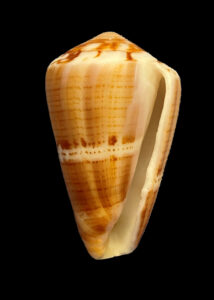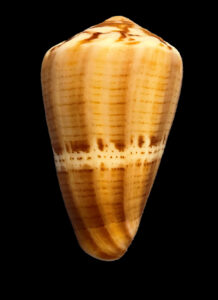Ribboned Cone Shell, Conus vittatus

 Ribboned Cone Shell, Conus vittatus. Shell collected off the beach at Punta Chivato, Baja California Sur, April 2022. Size: 4.8 cm (1.9 inches) x 2.9 cm (1.1 inches). Collection, photograph and Identification courtesy of Colin Campbell, DVM, Punta Chivato, Baja California Sur.
Ribboned Cone Shell, Conus vittatus. Shell collected off the beach at Punta Chivato, Baja California Sur, April 2022. Size: 4.8 cm (1.9 inches) x 2.9 cm (1.1 inches). Collection, photograph and Identification courtesy of Colin Campbell, DVM, Punta Chivato, Baja California Sur.
The Ribboned Cone, Conus vittatus (Hwass, C.H., 1792), is a gastropod mollusk that is a member of the Conidae Family of Cones. They are known in Mexico as cono ceñido. The shell has a convex spire. The shell varies in color from pink-brown, maculated or strigated longitudinally with light chestnut, with chestnut-dotted revolving striate and a ceritall white, chestnut maculated band mid-shell. Ribboned Cones reach a maximum of 5.0 cm (2.0 inches) in length.
Ribboned Cones are found under rocks and sand within the intertidal zone to depths up to 30 m (100 feet). In Mexican waters they are within coastal waters of the Pacific Ocean within the lower three-fourths of the Sea of Cortez and along the coast of the mainland south to Guatemala.
Synonyms include Conus reevei, Poremskiconus vittatus and Purpuriconus vittatus.
From a conservation perspective the Ribboned Cone is currently considered to be of Least Concern with stable, widely distributed populations. They are a minor component of shell trade collector market.